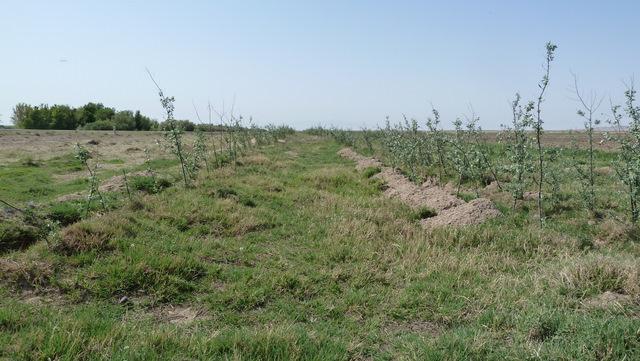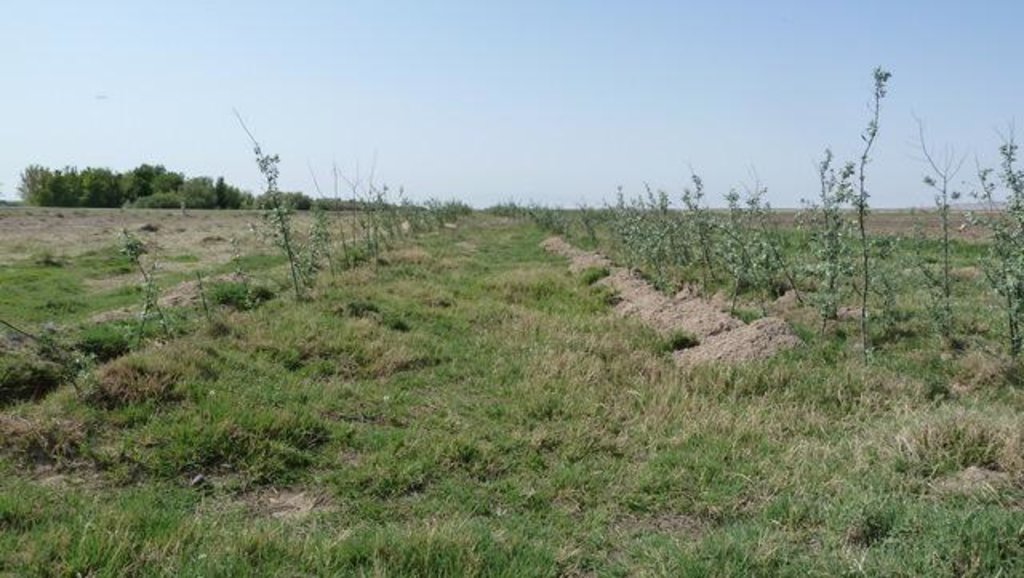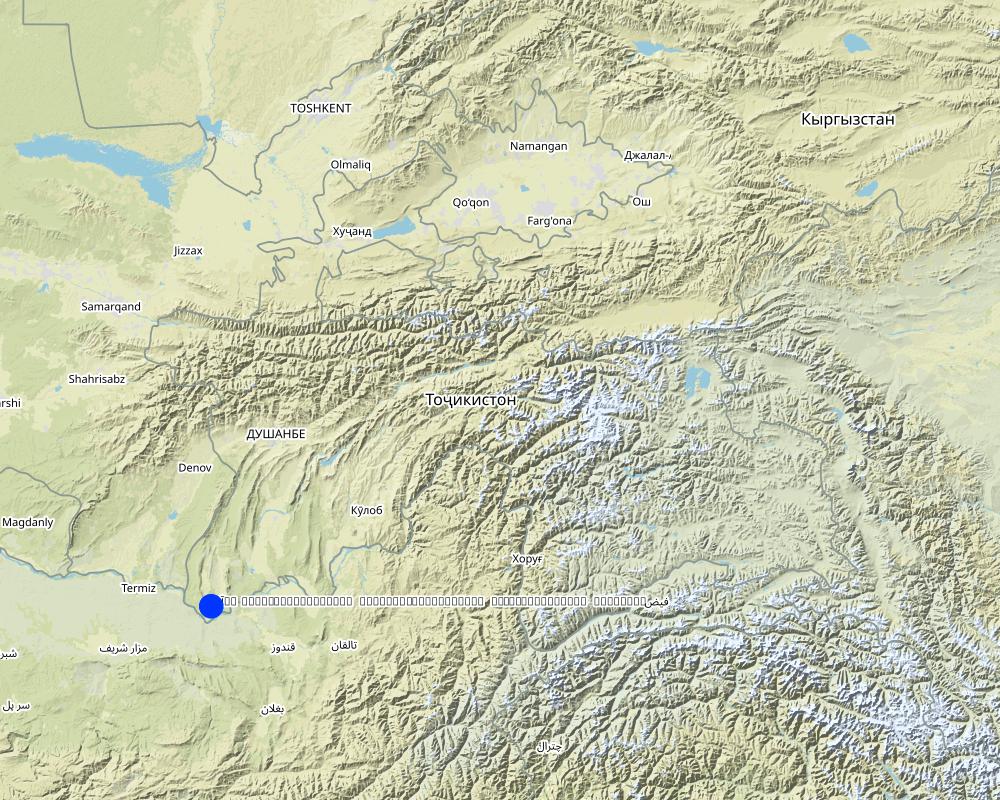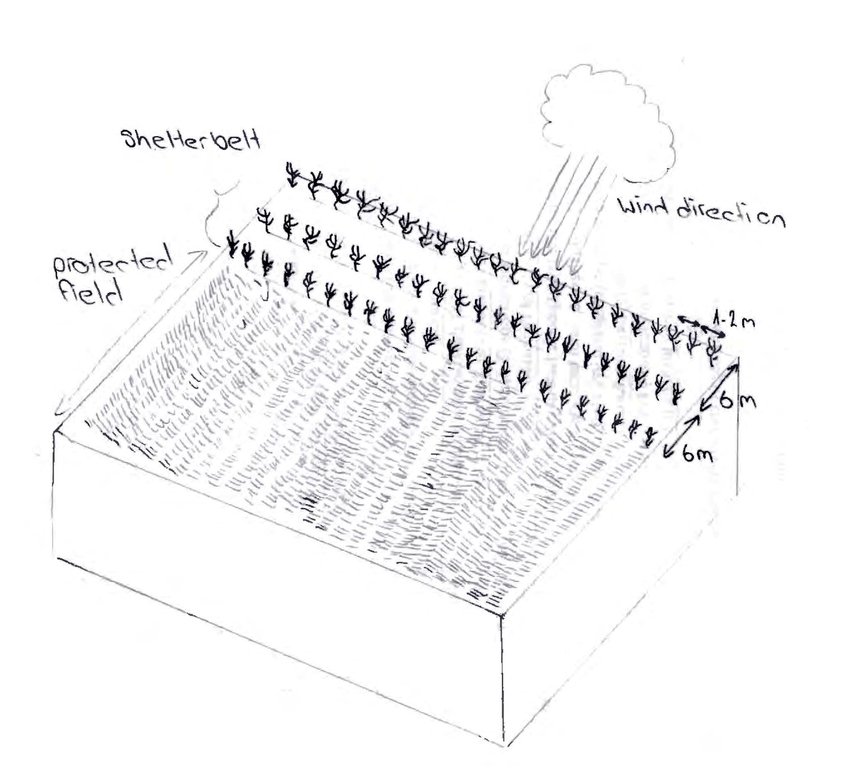Shelterbelts with Russian Silverberry for the protection of irrigated fields [塔吉克斯坦]
- 创建:
- 更新:
- 编制者: Firdavs Faizulloev
- 编辑者: –
- 审查者: Alexandra Gavilano, Deborah Niggli, Joana Eichenberger
Tajikistan - Central Asian Countries Initiative for Land Management (CACILM/ИСЦАУЗР)
technologies_1458 - 塔吉克斯坦
- Shelterbelts with Russian Silverberry for the protection of irrigated fields: Jan. 4, 2017 (inactive)
- Shelterbelts with Russian Silverberry for the protection of irrigated fields: July 20, 2017 (inactive)
- Shelterbelts with Russian Silverberry for the protection of irrigated fields: Aug. 21, 2019 (inactive)
- Shelterbelts with Russian Silverberry for the protection of irrigated fields: Nov. 2, 2021 (public)
查看章节
全部展开 全部收起1. 一般信息
1.2 参与该技术评估和文件编制的资源人员和机构的联系方式
SLM专业人员:
SLM专业人员:
Ibragimov Firuz
National Capacity Building Coordinator, Energy and Environment Programme, UNDP Tajikistan
塔吉克斯坦
有助于对技术进行记录/评估的项目名称(如相关)
Central Asian Countries Initiative for Land Management (CACILM I)有助于对技术进行记录/评估的项目名称(如相关)
Pilot Program for Climate Resilience, Tajikistan (WB / PPCR)1.3 关于使用通过WOCAT记录的数据的条件
编制者和关键资源人员接受有关使用通过WOCAT记录数据的条件。:
是
1.4 所述技术的可持续性声明
这里所描述的技术在土地退化方面是否存在问题,导致无法被认为是一种可持续的土地管理技术?:
否
2. SLM技术的说明
2.1 技术简介
技术定义:
Shelterbelts are used to protect irrigated land from deposition of sand and to reduce wind speed
2.2 技术的详细说明
说明:
This technology consists of shelterbelts made of Russian Silverberry (Elaeagnus angustifolia) to protect irrigated wheat and rice fields from strong winds.
In the Shaartuz area wind erosion poses huge problems to crop cultivation as topsoil is being removed and deposited as sediments on neighbouring fields. Dusty storms not only damage the crops but they also cause damage to the main surface, the fertile layer of soil. Sand also damages the irrigation canals, roads, gardens and streets in urban areas which forces people to leave such areas. Good yields cannot be achieved if fields are not properly protected.
A solution to this problem is the planting of shelterbelts around fields to slow wind speed and to prevent erosion of the arable soil layer. During Soviet times shelterbelts were planted on collective farms by the state forestry committee under contracts. After the collapse of the USSR and before the formation of Dehkan farms land users were not interested in investing in shelterbelts due to unprotected land use rights and unclear legal procedures. One farmer however tested the planting of a shelterbelt in 1992 when his son came back from his studies at the Agricultural University where he had learnt about the technology. They planted the first shelterbelt using a mixture of different tree species to protect newly irrigated fields. Due to financial constraints they could not invest in any other shelterbelts but in 2010 UNDP provided them with financial support to buy seedlings to increase the shelterbelt area. For this new shelterbelt the native Russian Silverberry (Elaeagnus angustifolia) was considered the most appropriate species as soils were highly saline and only this species proved tolerant.
Trees were planted in three rows, along field boundaries and also along irrigation channels. Within rows trees were spaced at a 1m interval with a 6 m distance between rows. The plantations were established through “haschar” (voluntary neighbourhood help) with 30 people planting about 10,000 trees within one month. During the first three years after planting the saplings need regular irrigation and sanitary cleaning to help establish themselves. After 6-7 years the trees start drawing a lot of water from the soil which prevents the irrigated soils from damage through water logging. Russian silverberry can grow up to 12 m in 10-12 years.
Benefits of these shelterbelts are increased crop yields (wheat and rice) due to the protection from strong winds and decreased evapotranspiration. Thanks to the species association with nitrogen fixing root bacteria soil fertility is improved. The trees further produce edible fruits and provide valuable firewood that is consumed by the households. Russian Silverberry is resistant to pests and diseases and drought-tolerant once established; however, it requires a lot of water during the first few years. One constraint to the establishment of the shelterbelt is local people who often cut down branches for firewood. The farmer therefore has to guard his field whenever possible with the help of his family and staff he has employed to work on his field. Implementation of forestry initiatives began in 2009 and a total of 11 ha land was covered between 2009-2010. 11 farmers were involved in the project and establishment of the shelterbelts was initiated stage by stage during these two years. The project initiatives have also continued into 2011 as well. As other farmers do observe and understand the importance of shelterbelts, there has been a trend towards adoption of the technology by other farmers.
2.3 技术照片
2.5 已应用该技术的、本评估所涵盖的国家/地区/地点
国家:
塔吉克斯坦
区域/州/省:
Khatlon
有关地点的进一步说明:
Shaartuz
具体说明该技术的分布:
- 均匀地分布在一个区域
如果不知道精确的区域,请注明大致覆盖的区域:
- < 0.1 平方千米(10 公顷)
注释:
Total area covered by the SLM Technology is 0.09 km2.
The technology has been applied by 11 different farmers on 9 ha of land
Map
×2.6 实施日期
如果不知道确切的年份,请说明大概的日期:
- 10-50年前
2.7 技术介绍
详细说明该技术是如何引入的:
- 在实验/研究期间
注释(项目类型等):
The land users son learnt about the technology while he studied at the agricultural university and the first shelterbelt was implemented through the land users own initiative
3. SLM技术的分类
3.1 该技术的主要目的
- 改良生产
- 保护生态系统
3.2 应用该技术的当前土地利用类型

农田
- 一年一作
- 多年一作(非木材)
年作 - 具体指明作物:
- 谷类 - 小麦(春季)
- 谷类 - 水稻(旱地)
多年生(非木质)作物 - 指定作物:
- 浆果类
- Silverberry (Elaeagnus angustifolia)
每年的生长季节数:
- 1
注释:
Major land use problems (compiler’s opinion): Dusty storms not only damage the crops but they also cause damage to the main surface, the fertile layer of soil. Sand also damages the irrigation canals, roads, gardens, streets in urban areas which can force people to leave such areas.
Major land use problems (land users’ perception): Wind erosion leading to deflation of sandy soils, low soil fertility, reduction of vegetation cover, and increasing impacts of climate change.
3.3 由于技术的实施,土地使用是否发生了变化?

不毛之地
具体说明:
wastelands, deserts, glaciers, swamps, recreation areas, etc
3.4 供水
该技术所应用土地的供水:
- 充分灌溉
3.5 该技术所属的SLM组
- 防风林/防护林带
3.6 包含该技术的可持续土地管理措施

植物措施
- V1:乔木和灌木覆盖层
注释:
Type of vegetative measures: aligned: -against wind
3.7 该技术强调的主要土地退化类型

土壤风蚀
- Et:表土流失
- Ed:风蚀风积
- Eo:场外劣化效应

生物性退化
- Bh:栖息地丧失
- Bq:数量/生物量减少

水质恶化
- Ha:干旱化
注释:
Main causes of degradation: over-exploitation of vegetation for domestic use, wind storms / dust storms, inputs and infrastructure: (roads, markets, distribution of water points, other, …) (breakdown of soviet irrigation systems and therefore abandonment of land)
3.8 防止、减少或恢复土地退化
具体数量名该技术与土地退化有关的目标:
- 减少土地退化
- 修复/恢复严重退化的土地
4. 技术规范、实施活动、投入和成本
4.1 该技术的技术图纸
技术规范(与技术图纸相关):
Shelterbelts consist of three rows of trees (Russian Silverberry). The rows are spaced 6 meters apart from each other and the interval between trees within the rows is 1-2 m.
Location: Shaartuz. Khatlon
Date: 27.05.2011
Technical knowledge required for field staff / advisors: low
Technical knowledge required for land users: low
Main technical functions: stabilisation of soil (eg by tree roots against land slides), reduction in wind speed
Secondary technical functions: increase of biomass (quantity)
Aligned: -against wind
Vegetative material: T : trees / shrubs
Number of plants per (ha): 1500
Spacing between rows / strips / blocks (m): 6
Vertical interval within rows / strips / blocks (m): 1-2
Trees/ shrubs species: Elaeagnus angustifolius (planted)
作者:
Julie Zaehringer, Baumackerstr. 51, 8050 Zuerich
4.2 有关投入和成本计算的一般信息
其它/国家货币(具体说明):
Somoni
如相关,注明美元与当地货币的汇率(例如1美元=79.9巴西雷亚尔):1美元=:
4.5
注明雇用劳工的每日平均工资成本:
5.50
4.3 技术建立活动
| 活动 | 时间(季度) | |
|---|---|---|
| 1. | Planting of grafting material or tree seedlings | December |
4.4 技术建立所需要的费用和投入
| 对投入进行具体说明 | 单位 | 数量 | 单位成本 | 每项投入的总成本 | 土地使用者承担的成本% | |
|---|---|---|---|---|---|---|
| 劳动力 | labour | ha | 1.0 | 720.0 | 720.0 | 100.0 |
| 植物材料 | seedlings | ha | 1.0 | 1350.0 | 1350.0 | |
| 技术建立所需总成本 | 2070.0 | |||||
| 技术建立总成本,美元 | 460.0 | |||||
注释:
Duration of establishment phase: 12 month(s)
4.5 维护/经常性活动
| 活动 | 时间/频率 | |
|---|---|---|
| 1. | Irrigation of seedlings | regularly during first three years |
| 2. | Sanitary cleaning of trees |
4.6 维护/经常性活动所需要的费用和投入(每年)
| 对投入进行具体说明 | 单位 | 数量 | 单位成本 | 每项投入的总成本 | 土地使用者承担的成本% | |
|---|---|---|---|---|---|---|
| 劳动力 | labour | ha | 1.0 | 85.0 | 85.0 | 100.0 |
| 技术维护所需总成本 | 85.0 | |||||
| 技术维护总成本,美元 | 18.89 | |||||
4.7 影响成本的最重要因素
描述影响成本的最决定性因素:
Labour was provided for free through the so-called "haschar" or neighborhood help.
5. 自然和人文环境
5.1 气候
年降雨量
- < 250毫米
- 251-500毫米
- 501-750毫米
- 751-1,000毫米
- 1,001-1,500毫米
- 1,501-2,000毫米
- 2,001-3,000毫米
- 3,001-4,000毫米
- > 4,000毫米
农业气候带
- 干旱
Thermal climate class: temperate
5.2 地形
平均坡度:
- 水平(0-2%)
- 缓降(3-5%)
- 平缓(6-10%)
- 滚坡(11-15%)
- 崎岖(16-30%)
- 陡峭(31-60%)
- 非常陡峭(>60%)
地形:
- 高原/平原
- 山脊
- 山坡
- 山地斜坡
- 麓坡
- 谷底
垂直分布带:
- 0-100 m a.s.l.
- 101-500 m a.s.l.
- 501-1,000 m a.s.l.
- 1,001-1,500 m a.s.l.
- 1,501-2,000 m a.s.l.
- 2,001-2,500 m a.s.l.
- 2,501-3,000 m a.s.l.
- 3,001-4,000 m a.s.l.
- > 4,000 m a.s.l.
5.3 土壤
平均土层深度:
- 非常浅(0-20厘米)
- 浅(21-50厘米)
- 中等深度(51-80厘米)
- 深(81-120厘米)
- 非常深(> 120厘米)
土壤质地(表土):
- 粗粒/轻(砂质)
表土有机质:
- 低(<1%)
5.4 水资源可用性和质量
地下水位表:
< 5米
地表水的可用性:
匮乏/没有
水质(未处理):
不良饮用水(需要处理)
5.5 生物多样性
物种多样性:
- 低
5.6 应用该技术的土地使用者的特征
生产系统的市场定位:
- 混合(生计/商业)
非农收入:
- 收入的10-50%
个人或集体:
- 个人/家庭
机械化水平:
- 手工作业
- 机械化/电动
说明土地使用者的其他有关特征:
Land users applying the Technology are mainly common / average land users
Annual population growth: 1% - 2%
5.7 应用该技术的土地使用者使用的平均土地面积
- < 0.5 公顷
- 0.5-1 公顷
- 1-2 公顷
- 2-5公顷
- 5-15公顷
- 15-50公顷
- 50-100公顷
- 100-500公顷
- 500-1,000公顷
- 1,000-10,000公顷
- > 10,000公顷
这被认为是小规模、中规模还是大规模的(参照当地实际情况)?:
- 中等规模的
5.8 土地所有权、土地使用权和水使用权
土地所有权:
- 个人,有命名
土地使用权:
- 个人
5.9 进入服务和基础设施的通道
健康:
- 贫瘠
- 适度的
- 好
教育:
- 贫瘠
- 适度的
- 好
技术援助:
- 贫瘠
- 适度的
- 好
就业(例如非农):
- 贫瘠
- 适度的
- 好
市场:
- 贫瘠
- 适度的
- 好
能源:
- 贫瘠
- 适度的
- 好
道路和交通:
- 贫瘠
- 适度的
- 好
饮用水和卫生设施:
- 贫瘠
- 适度的
- 好
金融服务:
- 贫瘠
- 适度的
- 好
6. 影响和结论性说明
6.1 该技术的现场影响
社会经济效应
生产
作物生产
饲料生产
生产故障风险
社会文化影响
contribution to human well-being
注释/具体说明:
through increased crop yield
生态影响
水循环/径流
蒸发
土壤
土壤流失
注释/具体说明:
reduced deflation
生物多样性:植被、动物
栖息地多样性
注释/具体说明:
shelterbelts can provide habitat to birds, insects etc.
减少气候和灾害风险
风速
6.2 该技术的场外影响已经显现
风力搬运沉积物
对邻近农田的破坏
注释/具体说明:
from prevention of deposition
6.3 技术对渐变气候以及与气候相关的极端情况/灾害的暴露和敏感性(土地使用者认为的极端情况/灾害)
渐变气候
渐变气候
| 季节 | 增加或减少 | 该技术是如何应对的? | |
|---|---|---|---|
| 年温度 | 增加 | 好 |
气候有关的极端情况(灾害)
气象灾害
| 该技术是如何应对的? | |
|---|---|
| 局地暴雨 | 好 |
| 局地风暴 | 好 |
气候灾害
| 该技术是如何应对的? | |
|---|---|
| 干旱 | 好 |
水文灾害
| 该技术是如何应对的? | |
|---|---|
| 比较和缓的(河道)洪水 | 未知 |
其他气候相关的后果
其他气候相关的后果
| 该技术是如何应对的? | |
|---|---|
| 缩短生长期 | 未知 |
6.4 成本效益分析
技术收益与技术建立成本相比如何(从土地使用者的角度看)?
短期回报:
轻度消极
长期回报:
积极
技术收益与技术维护成本/经常性成本相比如何(从土地使用者的角度看)?
短期回报:
中性/平衡
长期回报:
积极
注释:
the trees take time to establish during which the benefits are not yet tangible
6.5 技术采用
- > 50%
注释:
100% of land user families have adopted the Technology with external material support
11 land user families have adopted the Technology with external material support
There is a strong trend towards spontaneous adoption of the Technology
It is impossible to get good yield in these areas which are prone to strong winds without shelterbelts. Farmers do realise and understand the importance of shelterbelts and there is a trend towards growing spontaneous adoption of the technology.
6.7 该技术的优点/长处/机会
| 土地使用者眼中的长处/优势/机会 |
|---|
| Reduced deflation and deposition of sand on fields and therefore improved crop growth |
| Increased crop yield as before the establishment of shelterbelts no crops could grow on this land |
| Reduced wind speed |
| Russian Silverberry produces edible fruits rich in vitamins |
| Increased production area |
| 编制者或其他关键资源人员认为的长处/优势/机会 |
|---|
| Russian silverberry is a native tree species with high drought-tolerance and the ability to grow on nutrient-poor soils thanks to its root association with nitrogen fixing bacteria |
| Once established the shelterbelts do not need a lot of maintenance |
| Rehabilitation of unproductive, denuded land into productive cropland |
6.8 技术的弱点/缺点/风险及其克服方法
| 土地使用者认为的弱点/缺点/风险 | 如何克服它们? |
|---|---|
| The shelterbelts have to be protected from being damaged by local people who want to cut them for firewood | Awareness raising; increase of firewood supply through tree planting |
7. 参考和链接
7.1 信息的方法/来源
- 实地考察、实地调查
- 与土地使用者的访谈
(现场)数据是什么时候汇编的?:
14/04/2011
链接和模块
全部展开 全部收起链接
无链接
模块
无模块






